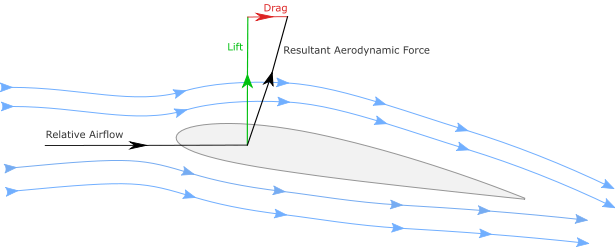Drag
Contents
Explanationedit
Drag is a mechanical force that opposes the motion of a body like an aircraft that travels in a fluid medium. The force arises from the interaction between the body and the fluid medium. The difference in the velocities of the two entities results in drag. When the free airflow encounters an airfoil it exerts an aerodynamic force on it due to the combined effect of newton’s third law of motion and Bernoulli’s principle. When this resultant force is resolved, the horizontal component is the drag and the vertical component is the lift as shown in the figure. The most common type of drag is the skin friction drag. The shape of the object also influences these factors much and contributes to the drag component as form drag and interference drag. The other forms of drag are induced drag and wave drag.
Frequently Asked Questionsedit
What is an induced drag?edit
Induced drag or lift-induced drag is a type of drag exclusively found on the wings of airplanes. The lift component of an aircraft is not distributed uniformly from the root of the wing to the tip of it. Due to the low-pressure region above the wing, the high-pressure air from below flows to the low-pressure area at the wing tip, forming wingtip vortices. These vortices significantly reduce the lift as some of the air required for the lift ‘leaks’ at the tip. The overall flow due to this vortices also results in the lift component to incline backward a little, opposing the forward motion.
What is a wave drag?edit
Wave drag is a type of drag that is localized to the surfaces of wings and propellers moving at transonic speeds. At this speed, some flow over these surfaces reach supersonic speed and form shockwaves that increase the drag abruptly. Beyond the critical Mach number, wave drag usually causes the aircraft to stall. In extreme cases, the wave drag becomes high enough to move the center of pressure of the aircraft aft to force the plane into a deep dive known as Mach tuck.

